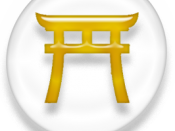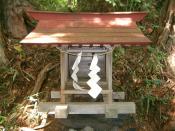Shintoism
The Shinto religion was started in the Tokugawa period
(1600-1868) of Japanese history. The Tokugawa "Enlightenment"
inspired a group of people who studied kokugaku, which roughly
translated means "nativism," "Japanese Studies," or "Native
Studies." Kokugaku's intent was to recover "Japanese character"
to what it was before the early influences of foreigners, especially
the Chinese. Some of these influences include Confucianism
(Chinese), Taoism (Chinese), Buddhism (Indian and Chinese), and
Christianity (Western European). The kokugakushu ("nativist")
focused most of their efforts on recovering the Shinto religion, the
native Japanese religion, from fragments of texts and popular
religious practices.
However, Shintoism is probably not a native religion of
Japan (since the Japanese were not the original "natives" of
Japan). There really is no one thing that can be called "Shinto,"
The name itself is a bit misleading because it is made up of two
Chinese words meaning "the way of the gods"(Shen : "spiritual
power, divinity"; Tao : "the way or path").
The word for this in
Japanese is kannagara : 'the way of the kami .'
Many things can be said about Shinto. First, it was a tribal
religion, not a state one. However, even when the tribes were
organized into coherent states, they still retained their Shinto
beliefs. Second, all Shinto cults believe in Kami ("the divine")
Individual clans worshipped a single Kami which was regarded as
the principal ancestor of the clan. As the clan spread, it still
worshipped it's Kami, but when one clan conquered another
clan-the defeated clan had to worship the Kami of the victorious
clan. What the Kami consist of is hard to define. Kami refers to
the gods of Heaven, Earth, and the Underworld. But Kami also
are all those things that have divinity in them to some degree.
Third, all Shinto involve...


